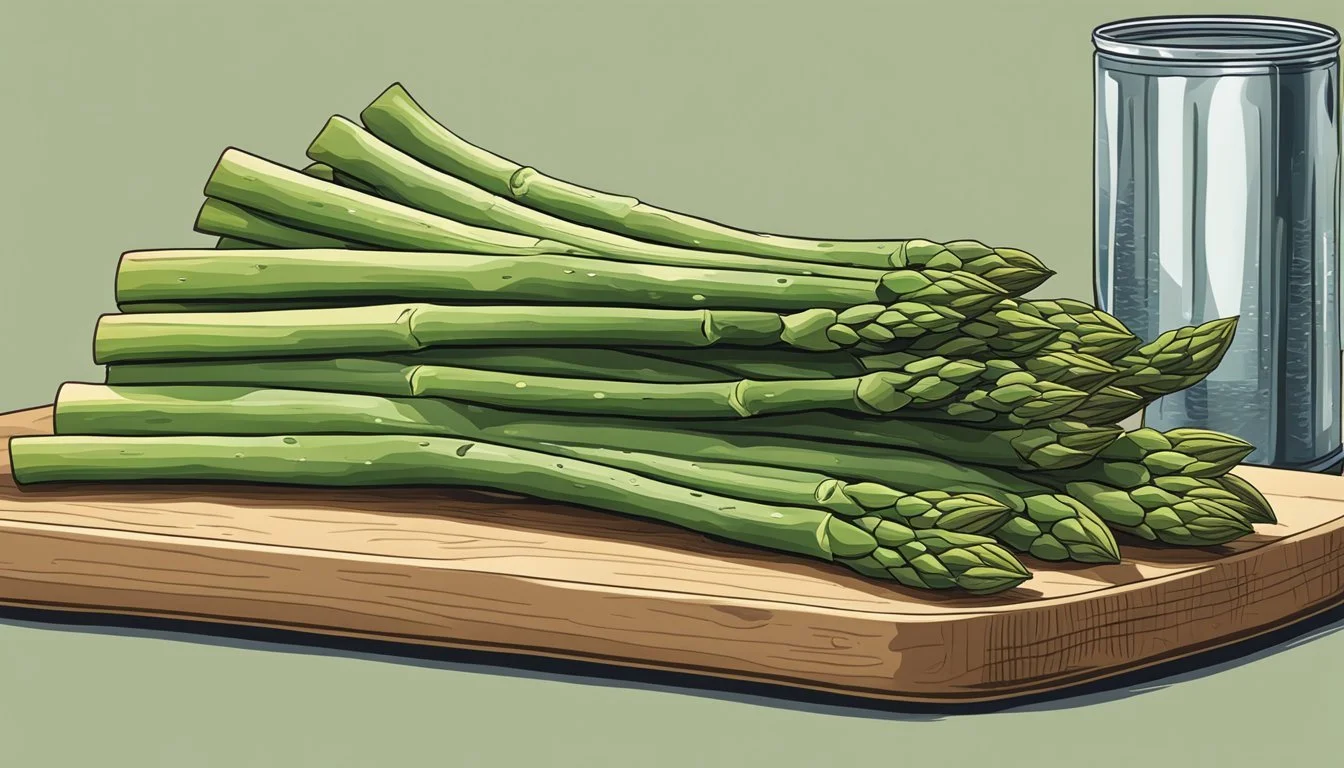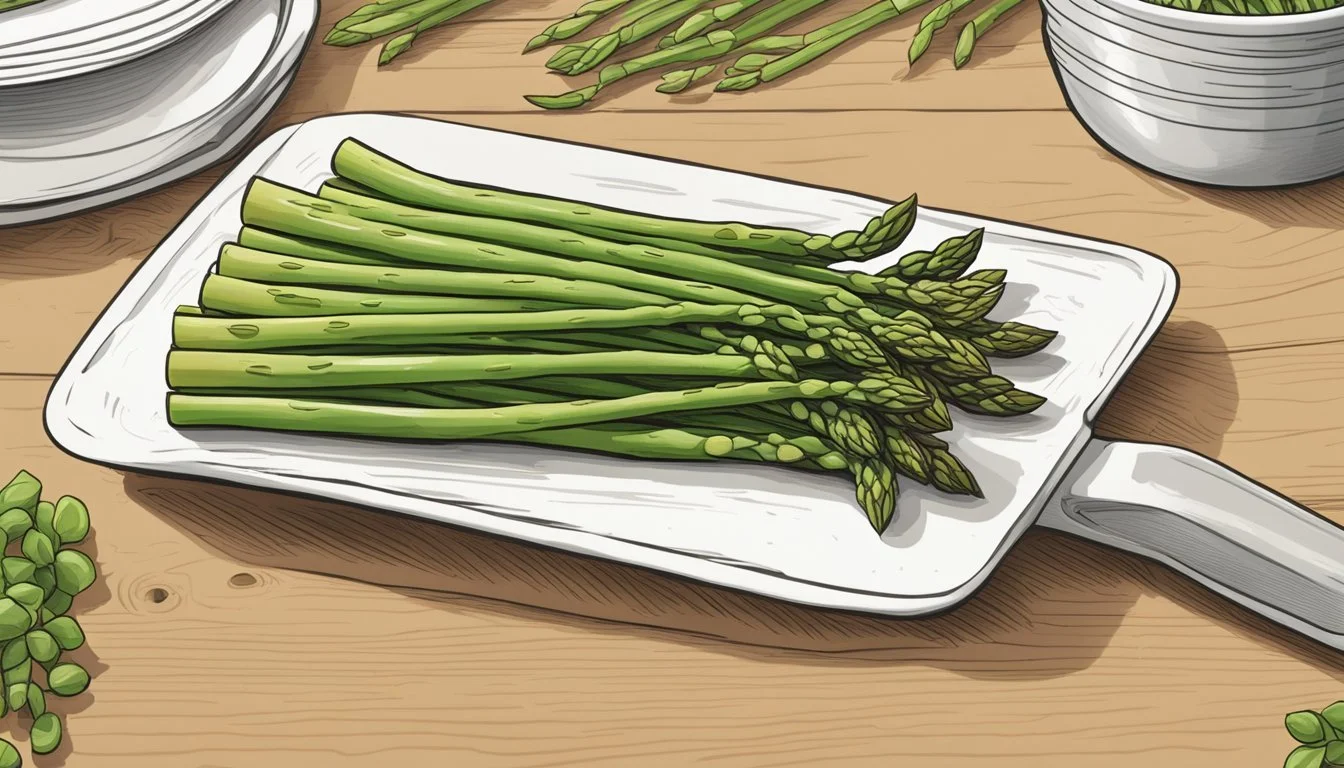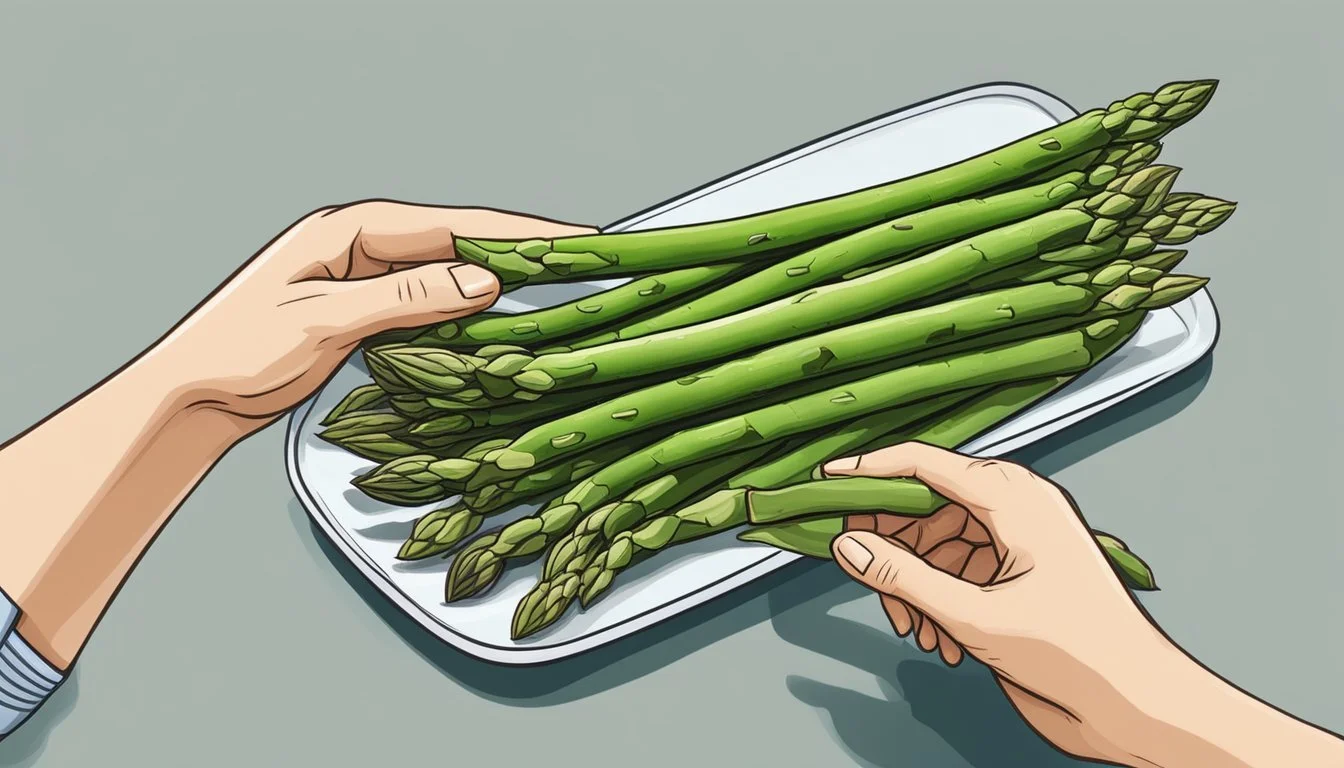How to Substitute Asparagus for Green Beans
A Simple Guide
When looking to bring a variation to the dinner table, substituting asparagus for green beans is an excellent choice. Asparagus, a perennial favorite known for its distinct flavor and nutritional benefits, can easily replace green beans in most recipes. The two vegetables share comparable cooking times and methods, which simplifies the substitution process. Whether the dish is sautéed, steamed, or baked, asparagus can bring a new dimension of taste and texture.
The key to a successful substitution lies in understanding the flavor profiles and textures of asparagus and green beans. Asparagus has a slightly more pronounced and earthy flavor compared to the subtle taste of green beans. However, when seasoned similarly, asparagus can complement the same dishes that typically feature green beans. It's also important to consider size and shape; asparagus stalks are generally thicker than green beans, which may require slight adjustments in cooking times to achieve the desired tenderness.
To substitute asparagus for green beans, one must ensure that the spears are prepared appropriately. For recipes requiring similar textures and crunch, such as in casseroles (What wine goes well with casseroles?) or stir-fries, cutting asparagus into bite-sized pieces is recommended. This not only mimics the mouthfeel of green beans but also allows the asparagus to distribute evenly throughout the dish, ensuring that each bite carries the substituted vegetable's unique flavor.
Understanding Asparagus and Green Beans
When considering substituting asparagus for green beans, it is essential to take into account their nutritional profiles, flavor, texture, availability, and environmental impact.
Nutritional Comparison
Asparagus and green beans both contribute beneficial nutrients to a diet, though their profiles differ slightly. Asparagus is well-known for its fiber content, providing about 2.1 grams per 100-gram serving. Green beans also contain fiber, with 2.7 grams for the same serving size, making them both excellent choices for digestive health.
Asparagus (per 100g):
Calories: 20
Fiber: 2.1g
Protein: 2.2g
Green Beans (per 100g):
Calories: 31
Fiber: 2.7g
Protein: 1.8g
Flavor Profiles
The flavor of asparagus can be described as earthy and slightly grassy with a distinct, mildly bitter taste. It has a tender texture when cooked, offering a unique flavor that is often enhanced by lemon or garlic in recipes. Green beans have a milder flavor profile, often described as slightly sweet and nutty. Both vegetables can be enjoyed steamed, blanched, or fried, but their flavors will shape the final taste of a dish.
Texture and Form
In terms of form, asparagus stalks tend to be thicker and fibrous at the end, requiring the removal of the tough base before cooking. Green beans are more uniform in texture and can be eaten whole. When cooked, asparagus becomes tender yet can retain a bit of a snap. Green beans, on the other hand, soften but hold their shape and texture, usually maintaining a slight bite.
Availability and Seasonality
Fresh asparagus is typically available in spring when it is at peak freshness and flavor, although imported asparagus can be found year-round in some areas. Green beans have a broader growing season, extending from summer into fall. Additionally, both vegetables are available in canned form, with green beans more commonly found than canned asparagus; white asparagus is another variety that may be available seasonally.
Environmental Impact
While the environmental impact varies based on growing practices, asparagus often requires more water and can have a larger carbon footprint, particularly when air-freighted from countries where it is not in season. Green beans typically have a lower environmental impact, especially when grown locally and seasonally. Consumers interested in reducing their food-related carbon footprint may prefer to purchase green beans during their local growing season.
Preparation Basics for Asparagus
In preparing asparagus, one must pay attention to proper washing and trimming, as well as the selection of cooking techniques to best complement its texture and flavor. Utilizing proper seasoning will enhance the vegetable's natural taste.
Washing and Trimming
Asparagus should be thoroughly washed under cool, running water to remove any dirt or residue. Trim the woody ends of each spear by bending them until they snap at a natural breaking point, or by cutting approximately 1 inch from the bottom.
Cooking Techniques
Asparagus can be cooked using a variety of methods, each yielding a distinct texture and flavor profile:
Roasted: Preheat oven to 400 degrees F. Toss asparagus with extra virgin olive oil, kosher salt, and black pepper. Roast for 12-15 minutes until tender and lightly browned.
Grilled: Heat grill to a medium-high. Brush asparagus spears with oil and season with salt and pepper. Grill for 5-10 minutes, turning occasionally, until charred and fork-tender.
Sautéed: Over medium-high heat, warm olive oil in a skillet. Add asparagus and a pinch of salt. Cook for about 5 minutes, occasionally stirring, until asparagus is a tender-crisp.
Steamed: Bring water to a boil in a pot fitted with a steamer basket. Place asparagus in the basket, cover, and steam for 3-5 minutes, depending on thickness.
Seasoning Asparagus
For seasoning asparagus, keep it simple to let the natural flavors shine through:
Salt and pepper: A sprinkle of kosher salt and freshly ground black pepper can be added before or after cooking.
Garlic: Add minced garlic to the pan when sautéing or roasting for a subtle, aromatic flavor.
Lemon: A squeeze of fresh lemon juice or zest can brighten the dish and add a zesty note.
Parsley: Chopped parsley sprinkled over cooked asparagus adds freshness and color.
Asparagus in Recipes
Asparagus serves as an excellent green bean substitute due to its similar crunch and ability to absorb flavors. This section explores how it can stand alone as a side, integrate into main dishes, and provide creative pairings in various recipes.
Asparagus as a Stand-Alone Side
A simple yet classic way to enjoy asparagus is by preparing it as a side dish. Roasting or grilling asparagus with olive oil and a sprinkle of salt can draw out its natural flavors. For a richer taste, asparagus can be topped with sauce; a drizzle of lemon juice and melted parmesan create a delectable combination. Asparagus may also be steamed and served with a light vinaigrette or a dollop of hummus to enhance its taste.
Integrating Asparagus into Main Dishes
When incorporating asparagus into main dishes, one can replace green beans in casseroles or stir-fries, maintaining the dish's texture and adding a new dimension of flavor. Asparagus pairs well with pasta, offering a fibrous bite in creamy sauces or with a toss of olive oil and garlic. It also complements protein-rich dishes such as chicken or fish, and can be baked into quiches (What wine goes well with quiche?) alongside cheese and onions.
Creative Substitutions and Pairings
Asparagus's versatility inspires creativity in substitutions and pairings. In salads, it adds a crunchy, nutritious element, pairing well with arugula, tomatoes, and feta cheese. It can also refresh pizza toppings or stand in for broccoli or snap peas in Asian-inspired dishes. Grilled asparagus tips tossed with roasted cauliflower, carrots, and zucchini make for a colorful medley, especially when paired with a tangy dressing or fresh herbs.
Swapping Asparagus for Green Beans
When substituting asparagus for green beans, it's important to consider cooking times and flavor profiles. Asparagus can bring a new level of sophistication to classic green bean dishes.
In Salads and Cold Dishes
Asparagus can be a fresh, vibrant addition to salads where green beans are traditionally used. For example, in a green bean salad, one can replace green beans with blanched asparagus. The goal is to maintain a similar crunch and color. Blanch the asparagus in boiling water for 2-3 minutes, then immediately transfer to ice water to preserve its bright green hue and crisp texture. Combine with ingredients like peas, avocado, and a dressing made with lemon juice and olive oil. The delicate flavor of asparagus pairs well with these counterparts, making it an ideal substitute in cold dishes.
In Cooked Dishes
When using asparagus as a substitute in cooked recipes such as casseroles or stir-fries, it's important to adjust the cooking time. Asparagus tends to cook faster than green beans. For a side dish featuring asparagus instead of green beans, consider roasting, sautéing, or grilling. To maintain similar textures, cut asparagus into bite-sized pieces and add them to the dish later than green beans would be added. If the recipe includes a sauce or cheese, asparagus will infuse the dish with its distinct, slightly earthy flavor.
Maintaining Textural Integrity
To ensure that asparagus remains a satisfactory substitute for green beans, its textural integrity is paramount. When blanched, remember not to overcook; it should remain firm and vibrant. Whether it's incorporated into a pasta dish, a creamy casserole, or served as a standalone side, the asparagus should offer a comparable bite to green beans. If roasting, a short stint in the oven at a high temperature leads to tender yet firm spears, while grilling can impart a slightly charred, robust edge.
Special Considerations
When substituting asparagus for green beans in a recipe, it is crucial to consider how this change affects cooking times, the balance of flavors, and any potential dietary restrictions. These special considerations ensure the final dish maintains its intended quality and appeal.
Adjustments for Cooking Times
Asparagus: Generally requires less cooking time compared to green beans. For instance, asparagus can become tender within 3-5 minutes of boiling, depending on its thickness.
Green Beans: Typically take about 5-7 minutes to cook through when boiled.
Vegetable Boiling Time Asparagus 3-5 minutes Green Beans 5-7 minutes
When roasting, both asparagus and green beans benefit from being cooked until slightly caramelized, enhancing their natural flavors.
Balancing Flavors
Asparagus brings a distinct, slightly grassy flavor to dishes, which can alter the taste profile of a recipe originally calling for green beans. To balance flavors:
Salt and Pepper: Both seasoning staples should be adjusted to taste.
Garlic: Adds depth and complements asparagus well. Be cautious as it can easily overpower the more delicate flavor of asparagus.
Lemon: A squeeze of lemon can brighten the dish and pairs excellently with asparagus.
Substituting one vegetable for another may call for a reduction or increase in other flavorful ingredients like herbs and spices to achieve a pleasant balance.
Allergy and Dietary Restrictions
Both asparagus and green beans are typically safe for most diets, being naturally gluten-free and vegan. However, when amending recipes, it is vital to consider:
Nutrients: Asparagus is rich in fiber, folate, and vitamins A, C, and K. Introducing it into a recipe adds nutritional variety.
Fiber Content: Green beans and asparagus possess different fiber amounts, which can be an important consideration for dietary fiber requirements.
By carefully adjusting these parameters, one can successfully substitute asparagus for green beans while maintaining the integrity of the dish.
Additional Tips and Tricks
When substituting asparagus for green beans, chefs should consider not just the cooking time but also the potential elevation of the dish with additional ingredients and diverse cooking methods.
Enhancing with Additional Ingredients
Preparation: Before they begin, cooks should ensure the asparagus is trimmed properly to remove the woody ends. Cheese, such as a sprinkle of Parmesan or grated cheddar, can meld beautifully with the natural flavor of asparagus. Adding crispy bacon pieces can provide a delightful textural contrast and savory depth. For a creamy taste with a touch of luxury, consider folding in some diced avocado just prior to serving. Finally, a garnish of chopped parsley not only adds a burst of color but also a fresh, herby finish to the dish.
Alternative Cooking Methods
Cooking Notes: Asparagus can be cooked using a variety of methods, each bringing out a unique flavor profile. To roast asparagus, position them in a single layer on a baking sheet, drizzle with oil, and cook in a preheated oven until tender. Grill asparagus for a smoky flavor by placing them over medium heat for a few minutes, turning occasionally. When opting to sauté, one should use a pan with a bit of oil or butter over medium heat until the asparagus is tender yet slightly crisp. For a crisp texture, fried asparagus can make an interesting addition to a casserole, ensuring to fry them briefly to maintain their nutritional integrity.
Conclusion
In exploring alternative vegetable options, asparagus stands out as a versatile and nutrient-dense choice to replace green beans in recipes. One benefits from its substantial vitamin content and the similar ways it can be cooked.
Final Thoughts on Substituting Asparagus
Substituting asparagus for green beans can enrich a recipe with a distinct flavor and a boost in nutrients such as vitamins A, C, E, and K. When modifying a recipe, chefs should consider the cooking time and method, as asparagus may require different handling to achieve the desired texture. Asparagus’s firm stalks and tender tips offer a unique texture that can enhance a variety of dishes, from casseroles to sautéed sides.
By incorporating asparagus as a substitute, one can maintain the integrity of a dish while introducing new dimensions to its taste and presentation. Whether roasted, steamed, or baked, asparagus proves to be a suitable alternative for green beans, offering a refined twist to classic recipes.
Appendices
This section provides supplementary information to enhance one's understanding and application of substituting asparagus for green beans in recipes. It includes a curated selection of ratings and reviews, a detailed nutritional analysis, practical cooking notes, and a section for private notes for personal adjustments.
Recipe Ratings and Reviews
To assess the success of a substitute recipe, one can refer to Recipe Ratings and Reviews. These ratings convey the public's response to the substitute, giving insight into its popularity and usefulness.
Average Rating: 4.5/5
Top Review Highlights:
"Substitution kept the flavors intact"
"Nutrient retention was excellent with this swap"
"Quality of substitute was beyond expectations"
Nutritional Analysis
The Nutritional Analysis compares the nutritional content of green beans and asparagus to help readers make informed decisions.
Nutrient Asparagus per 100g Green Beans per 100g Calories 20 kcal 31 kcal Fiber 2.1 g 2.7 g Vitamins & Minerals Contains vitamins A, C, E, and K, iron, calcium, and magnesium Rich in vitamins C and K, manganese, and fiber
Asparagus is notably lower in calories and has a unique vitamin and mineral profile compared to green beans. However, green beans offer more fiber.
Cooking Notes
When substituting asparagus for green beans, Cooking Notes indicate that one should remain aware of the textural and flavor differences between the two vegetables. Asparagus tends to cook faster than green beans and has a more pronounced flavor.
Texture: Asparagus is more tender; adjust cooking times accordingly.
Flavor Pairings: Asparagus pairs well with lemon and butter; green beans are more versatile.
Private Notes for Personal Adjustments
Individuals are encouraged to document their own experiences in the Private Notes for Personal Adjustments. This allows one to tailor the recipe more closely to personal preferences or dietary needs.
Note the preferred substitution ratio (1 cup green beans:1 bunch asparagus)
Adjust seasoning and spices to complement the bolder taste of asparagus









